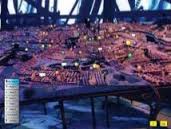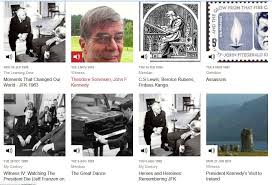Here’s part 1 if you missed it – https://cultureandcrafts.wordpress.com/2013/11/24/museums-on-the-web-mcg-conference-2013-part-1/
So after a good look around the Tate shop and adding a book on Nano houses and a hypertrochoid set (aka Spirograph for those of us old enough to remember it!) to my Christmas list, I returned to the conference excited at the ‘Lightning Sessions’ that started the afternoon’s talks. The first speaker was Jane Finnis from Culture 24, who had the best slide of the lightning sessions, talking about ‘Let’s Get Real’ phase 3, ‘Is your content fit for purpose?’ Jane made us think about how we can better promote exhibitions, events, and collections online, and talked about guides to SEO, social media, and Google Analytics that Culture 24 are currently creating to help cultural organisations improve digital content.
James Morley followed with his crowdsourcing prototype for cultural collections GathrIt. It allows people to curate their own collections across multiple cultural websites, with geotagging, comments, social media sharing and search facilities. At the moment it’s available as a user installed toolbar, and in the future collection managers will be able to add it to their websites, so visitors can see the data even if they don’t already have the toolbar. The website has a great demo at http://www.gathr.it. Sarah Saunders from Electric Lane was very passionate about embedding metadata into images from the heritage sector to retain it’s intellectual and property data, so when images are downloaded they can still be easily identified. This would help not only heritage professionals, but also teachers, students, anyone interested in finding out more about an image they’ve seen online. It would help drive traffic to museum websites, exhibitions, and promote learning – lots of great reasons!
Marcus Winter took a second turn on the stage demonstrating his idea of social object labels. A small label device next to a museum object allows you to use your device to add your comments to the mix as well as seeing what others have written. I wasn’t too sure about this as it seemed as though a museum would need a device for each object to allow full interactivity in a gallery. All the way from the Historisches Museum Frankfurt the next speaker Franziska Mucha spoke about the transformation of the museum from a specialist historical museum towards a focus on Frankfurt’s city history. The Museum’s shift to a more interactive style has inspired the Frankfurt Now! project, with an interactive map over a model of Frankfurt so users will be able to freely explore the city’s past and select the information that piques their interest, customising their experience.
 In the ‘Grassroots meets technology section’ Tristan Ferne from BBC Research & Development revealed how the BBC is trialling putting the World Service radio archive online and using both algorithms and humans to tag and categorise the programmes. Once users have registered for free, they can listen to programmes from the archive and add tags relevant to the content, and make suggestions for improvements to computer generated tags. This not only allows users to contribute to the project, but also refines the algorithms. The BBC are also sharing some of the code used to categorise the audio on their GitHub site, which is bound to interest developers on similar projects.
In the ‘Grassroots meets technology section’ Tristan Ferne from BBC Research & Development revealed how the BBC is trialling putting the World Service radio archive online and using both algorithms and humans to tag and categorise the programmes. Once users have registered for free, they can listen to programmes from the archive and add tags relevant to the content, and make suggestions for improvements to computer generated tags. This not only allows users to contribute to the project, but also refines the algorithms. The BBC are also sharing some of the code used to categorise the audio on their GitHub site, which is bound to interest developers on similar projects.
 Then Paul Long from Birmingham Music Archive spoke about how the music industry already has an ongoing involvement with heritage, back catalogues are constantly being republished as box sets and anniversary editions. The Birmingham area has benefited from various Heritage Lottery Fund grants to establish and maintain music archives with the public being requested to share photographs and stories, creating conversations between users as they remember gigs they attended and discuss venues, forming a collective cultural memory. The various projects are socially inclusive as anyone can join in, and reflect the huge cultural and genre diversity of the region, with all kinds of music from Bhangra to heavy metal.
Then Paul Long from Birmingham Music Archive spoke about how the music industry already has an ongoing involvement with heritage, back catalogues are constantly being republished as box sets and anniversary editions. The Birmingham area has benefited from various Heritage Lottery Fund grants to establish and maintain music archives with the public being requested to share photographs and stories, creating conversations between users as they remember gigs they attended and discuss venues, forming a collective cultural memory. The various projects are socially inclusive as anyone can join in, and reflect the huge cultural and genre diversity of the region, with all kinds of music from Bhangra to heavy metal.
After another break the final sessions of the day were upon us. This is the first time I’ve been to a conference and not felt tired by the final sessions, just excited to try out some of the websites from the day. When I’d spotted the beautifully titled session ‘Crowdsourcing a Community Collection’ I’d been really interested, as it sounded similar to the Little Museum of Dublin sourcing their collection from the people of the city – and it’s one of my favourite museums. The comparison between the poetry digital archive and the First World War digital archive cost wise was significant, as with the war archive the contributors were usually uploading and cataloguing their own contributions, with data checked by the team. The poetry archive was delivered as high quality files, all the work was carried out by trained professionals and so this made the project over 10 times more expensive. I like the crowdsourcing concept because there are no issues with disposal of physical objects or ownership, and the communities online have generated stories and discussions about the archive. Hearing about the impact of the projects was really interesting, there’s a website to help anyone thinking of setting up their own community collection online – http://projects.oucs.ox.ac.uk/runcoco/ – people who wanted to come along to one of the collecting days got to discuss their items with others, like a specialised Antiques Roadshow day. Lots of other projects have sprung up as a result of the success of the community collection, an inter-generational theatre production and the Woruldhord project, which as well as being an online collection also provides free educational resources relating to the Anglo-Saxons.
Britain From Above was the penultimate project discussed by Sandra Brauer from English Heritage. A vast collection of 95,000 negatives needed to be catalogued, along with events and outreach projects to promote the archive, and publication of the Aerofilms story. It’s free to register on the site and then users can comment on the photographs and join in online discussions. My favourite part of this presentation was the knitted planes and I’ve already got my hands on some patterns to try them out! I also liked the way users can add locations into the photographs too, and that the volunteer community encouraged everyone to contribute.
The final talk was on ‘Diaries of the First World War’ by Jim O’Donnell and any talk that includes slides of animals always has my attention! Jim is the project developer for Zooniverse, and in partnership with the Imperial War Museum, is carrying out a large-scale ‘citizen history’ project. Diaries from the First World War, held by the National Archives, are going to be uploaded onto a website and tags added, from location geotags to classifying the weather and any objects mentioned. It was fascinating to see the process behind the creation of the different categories of tag, and the processes reminded me of a project I worked on last year creating a database for a museum catalogue. The project itself also made me think of a similar project that relies on collaboration with the public to transcribe letters about aspects of Irish life during this period, Letters of 1916 (http://dh.tcd.ie/letters1916/diyhistory/items/show/35) Zooniverse has a wealth of projects on the website – https://www.zooniverse.org/ – to get involved with, I only wish I had more time!
Categorising the diary data
 Unfortunately I missed the closing keynote by Michael Gorman of the Science Gallery in Dublin, which was a shame as I just heard his colleague Ian speak at the Irish Museum Association’s Museums & Technology seminar the week before and he was very entertaining. All in all I thought the day was good value for money, had a great location – both for being in the middle of a great museum and having good facilities, and was well planned time wise. I met some lovely people who gave me helpful suggestions of contacts to make and technologies to try, and learned so much I need more hours in the day to look over my notes and try out the projects discussed!
Unfortunately I missed the closing keynote by Michael Gorman of the Science Gallery in Dublin, which was a shame as I just heard his colleague Ian speak at the Irish Museum Association’s Museums & Technology seminar the week before and he was very entertaining. All in all I thought the day was good value for money, had a great location – both for being in the middle of a great museum and having good facilities, and was well planned time wise. I met some lovely people who gave me helpful suggestions of contacts to make and technologies to try, and learned so much I need more hours in the day to look over my notes and try out the projects discussed!
